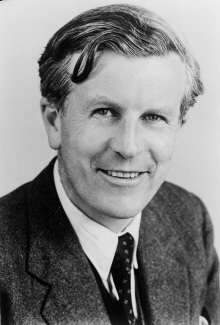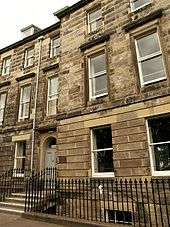Jo Grimond
| The Right Honourable The Lord Grimond CH CBE TD PC | |
|---|---|
 | |
| Leader of the Liberal Party | |
|
In office 12 May 1976 – 7 July 1976 | |
| Preceded by | Jeremy Thorpe |
| Succeeded by | David Steel |
|
In office 5 November 1956 – 17 January 1967 | |
| Preceded by | Clement Davies |
| Succeeded by | Jeremy Thorpe |
| Member of Parliament for Orkney and Shetland | |
|
In office 23 February 1950 – 9 June 1983 | |
| Preceded by | Basil Neven-Spence |
| Succeeded by | Jim Wallace |
| Personal details | |
| Born |
Joseph Grimond 29 July 1913 St Andrews, Fife, Scotland, UK |
| Died |
24 October 1993 (aged 80) Glasgow, Scotland, UK |
| Political party |
(1) Liberal Party (2) Liberal Democrats |
| Alma mater | Balliol College, Oxford |
Joseph Grimond, Baron Grimond CH CBE TD PC (29 July 1913 – 24 October 1993), known as Jo Grimond, was a British politician, leader of the Liberal Party from 1956 to 1967 and again briefly on an interim basis in 1976.
Jo Grimond was a long-term supporter of Scottish home rule; and, during his leadership, he successfully argued that the Liberal Party support the abolition of Britain's nuclear arsenal.[1]
Early life

Grimond was born in St Andrews, Fife, and educated at Eton College and Balliol College, Oxford. He was at school and university with, among others, cricket commentator Brian Johnston and playwright William Douglas-Home. He received a First Class honours degree in Politics, Philosophy and Economics. He became a barrister, being admitted to the bar as a member of Middle Temple.
Member of Parliament
After serving as a major in World War II, he was selected by the Liberal Party to fight Orkney and Shetland, the most northerly constituency in the United Kingdom. He narrowly missed capturing the seat in 1945 but entered Parliament in the 1950 general election and continued to represent the constituency until he retired from politics in 1983. He regularly polled more than 60% of the votes cast in the northern Scottish archipelagos.
Leader of the Liberal Party
The party Grimond inherited from former leader Clement Davies had commanded barely 2.5% of the vote at the general election of 1955, but even that figure amounted to a modest revival in Liberal Party fortunes. This progress increased under the leadership of Grimond who proved himself to be a man of considerable personal charm and intelligence, with substantial gifts as public speaker and as an author. Widely respected as well as trusted, he ensured that by the time he left the leadership in 1967, the Liberals had once again become a notable political force. It was during his tenure that the first post-war Liberal revival took place: under Grimond the Liberals doubled their seats and won historic by-elections at Torrington in 1958 (the first by-election gain by the Liberal Party for 29 years), Orpington in 1962, and Roxburgh, Selkirk and Peebles in 1965.
In the year of the Orpington by-election, the Liberals almost succeeded in capturing Blackpool North, West Derbyshire and Chippenham from the Conservatives. Grimond's dynamic and principled leadership proved attractive to many young aspiring politicians, including John Pardoe and three future party leaders, David Steel, Paddy Ashdown and Sir Menzies Campbell. He appealed to all wings of the party and was especially popular with the Young Liberals. In 1967, having led the party through three general elections, he made way for a younger leader, the charismatic Jeremy Thorpe. In 1976, when Thorpe was forced to resign because of a scandal, Grimond stepped in as caretaker leader until the election of a replacement, David Steel.[2]
Among other posts, Grimond was a barrister and publisher in the 1930s, an army major during World War II, Secretary of the National Trust for Scotland from 1947 to 1949, and held the Rectorships of the University of Edinburgh and the University of Aberdeen and the Chancellorship of the University of Kent at Canterbury (elected in 1970). His many books include The Liberal Future (1959, credited with reinvigorating radical liberalism as a coherent modern ideology), The Liberal Challenge (1963), and Memoirs (1979).
Retirement and death
On leaving the Commons, he was created a life peer as Baron Grimond, of Firth in the County of Orkney on 12 October 1983.[3] He remained devoted to his former parliamentary constituency, and was buried in Orkney.
Marriage and children
In 1938 he married Laura Bonham Carter (1918–1994). His wife was the granddaughter of the last Liberal Prime Minister, H. H. Asquith, the daughter of the influential Liberal politician and life peeress Violet Bonham Carter (1887–1969) and her politician and civil servant husband Maurice Bonham Carter. She was also the sister of another life peer Mark Bonham Carter (1922–1994) who was the victor of the 1958 by-election at Torrington. The couple had four children:
- (Joseph) Andrew Grimond (26 March 1939 – 23 March 1966),[4] a sub-editor of The Scotsman, lived in Edinburgh until his suicide at the age of 26.
- Grizelda "Gelda" (Jane) Grimond (born 1942), who had a daughter Katherine (b. 1973) by the film and stage director Tony Richardson.
- John (Jasper) Grimond (born October 1946), a former foreign editor of The Economist as Johnny Grimond, now writer at large for the publication, who in 1973 married Kate Fleming (b. 1946), elder daughter of the writer Peter Fleming and actress Celia Johnson, and has three children with her. He is the main author of The Economist Style Guide[5]
- (Thomas) Magnus Grimond (born 13 June 1959),[6] journalist and financial correspondent, married to travel author Laura Grimond (née Raison), and has four children.
Writings
- The Liberal Future (Faber and Faber, London, 1959)
- The Liberal Challenge (Hollis and Carter, London, 1963)
- The Referendum (with Brian Nevel; Rex Collings, London, 1975)
- The Common Welfare (Temple Smith, London, 1978)
- Memoirs (Heinemann, London, 1979)
- A Personal Manifesto (Martin Robertson, Oxford, 1983)
- The St. Andrews of Jo Grimond (Alan Sutton, St. Andrew's, 1992)
Grimond was also a prolific writer of pamphlets: see the McManus biography (below) for a complete list of publications.
References
- ↑ "Liberal Democrat History Group". liberalhistory.org.uk.
- ↑ BBC website – Jeremy Thorpe – Former Liberal Party Leader in the UK. Accessed 2 December 2013
- ↑ The London Gazette: no. 49511. p. 13655. 18 October 1983.
- ↑ "Hon. Laura Miranda Bonham Carter".
- ↑ "The Hon. John Grimond".
- ↑ Barberis 2005, p. 81.
- Peter Barberis, Liberal Lion: Jo Grimond, A Political Life (I.B. Tauris, London, 2005)
Further reading
| Wikiquote has quotations related to: Jo Grimond |
- Michael McManus, Jo Grimond: Towards the Sound of Gunfire (Birlinn, Edinburgh, 2001)
Sources
- Hansard 1803–2005: contributions in Parliament by Jo Grimond
- Jo Grimond (Lord Grimond) 1913–93 biography from the Liberal Democrat History Group
| Parliament of the United Kingdom | ||
|---|---|---|
| Preceded by Sir Basil Neven-Spence |
Member of Parliament for Orkney and Shetland 1950–1983 |
Succeeded by Jim Wallace |
| Party political offices | ||
| Preceded by Frank Byers |
Liberal Chief Whip 1950–1956 |
Succeeded by Donald Wade |
| Preceded by Clement Davies |
Leader of the British Liberal Party 1956–1967 |
Succeeded by Jeremy Thorpe |
| Preceded by Jeremy Thorpe |
Leader of the British Liberal Party 1976 |
Succeeded by David Steel |
| Academic offices | ||
| Preceded by James Robertson Justice |
Rector of the University of Edinburgh 1960–1963 |
Succeeded by James Robertson Justice |
| Preceded by Frank George Thomson |
Rector of the University of Aberdeen 1969–1972 |
Succeeded by Michael Barratt |
| Preceded by The Duchess of Kent |
Chancellor of the University of Kent 1970–1990 |
Succeeded by Sir Robert Horton |
| ||||||||||||||
|